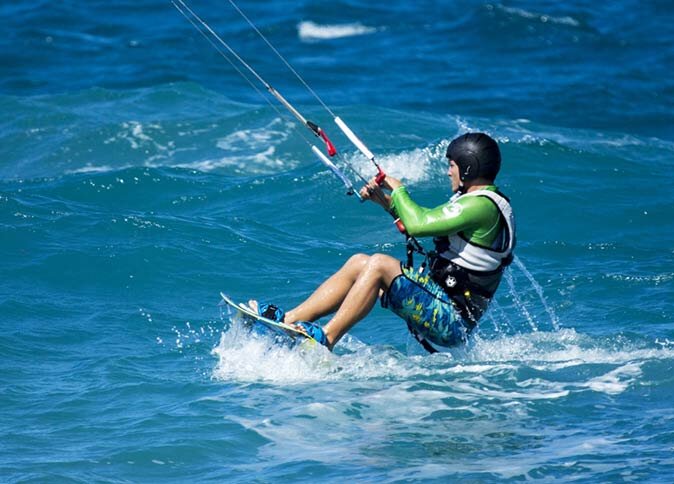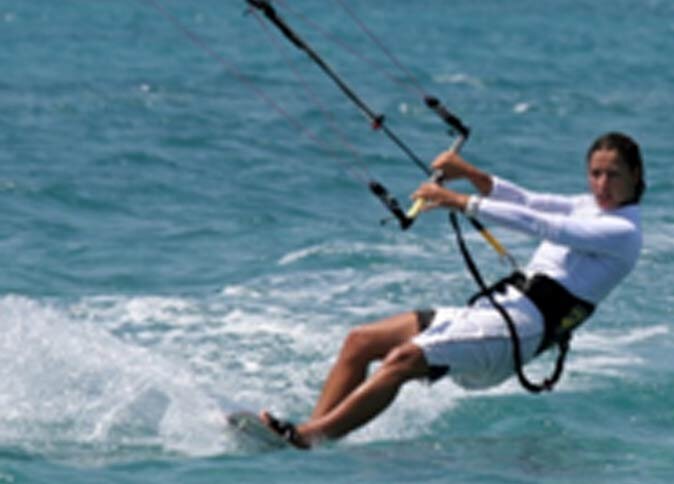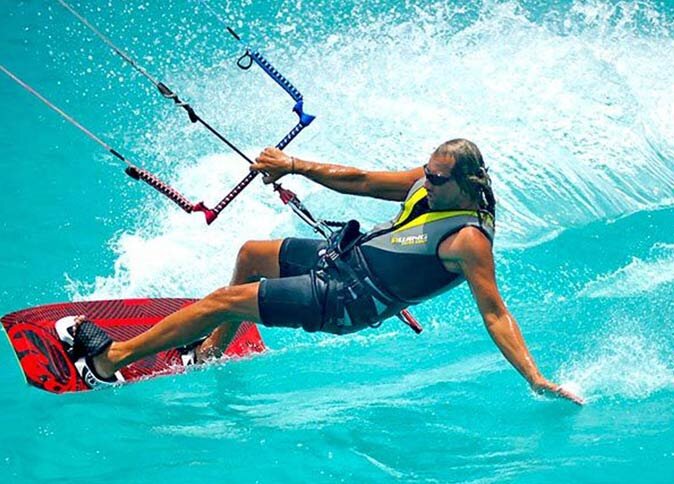The sport of kitesurfing consists of two major dimensions, 1) kite = precision bar control &2) board = body, board, balance.

Precision bar control
In itself kitesurfing is based on a 3 dimensional wind window which is dissimilar to windsurfing or sailing being a 2 dimensional wind plane. Yes, as you read correctly, that give sat least 5 dimensions to the sport we all love so much.

On top of that at each skill level throughout your progression levels to learn kite & bar control, as likewise board start positioning consisting of body, board, balance has its own unique multidimensional cognitive and physical attributes that needs to be learned.

What we are going to micro analyse and precision detail here is,101 A & B board start position, 102 front & back leg positioning 103 body board balance for first rides 104 hip weight distribution and riding upwind.
In which all of the above as like wise much more needs to combine together with precision execution in that millisecond that you turn the kite into the power zone, otherwise it becomes superman/woman time.

Super woman time
Board start position is quite simple in theory, albeit more challenging once strapped to a human size kite and trying to balance yourself buoyant on the water hence thus forth sitting back and ready to send the kite into the power zone.
Once you have mastered your board start position and technique, as likewise first rides the bell curve starts to go very quickly from here.As you will then have time on the water to grasp the feel for kitesurfing as ultimately riding upwind and independently. This is where the fun really begins.
Level 101-A
Board Start Position
Park the kite at 12 O’clock! Board parallel to the leading edge of the kite at 12. Breathe

Kite correctly parked at 12 O’clock before attempting board start
 Heel edge of the board parallel to the kite at 12 O’clock
Heel edge of the board parallel to the kite at 12 O’clock

Breathe
You will need to have your kite parked at the 12 O’clock position once you sit back in the water and put the board on. Any major movement of the kite from the 12 O’clock position and you will more than likely spin around sideways or backwards in the water, because the difficulty at this skill level is trying to find your balance while being buoyant on the water. You are not attempting to ride off into the sunset just yet,

only trying to stabilise your body in board start position.To prevent yourself from spinning around backwards to the kite which is all in your hip strength in relation to the heel edge of the board,a level of progression in itself.

Of course, it makes it much easier when you have an experienced instructor helping stabilise your body.
Or you can take one hand off the bar and try and splash your way back into position if you find yourself spinning around as you do not want to be backwards from the kite. If you are let go of the bar.
Repeat: Not because we like repeating ourselves but because of its importance. If you do find yourself spinning past 90 degrees from your board being parallel to the leading edge of the kite at 12, then let go of the bar, or you will end up backwards and going upside down backwards superman as your steering control will be opposite, as you pull left the kite will go right and vice versa). Yikes that’s not the kind of superman/woman you want to go.
You do not want your body to be like jello while sitting in board start position or you will end up backwards to the kite. It’s all in your hip strength and stabilising the kite at 12.
101 -B
Adjusted beginner level board-start position 45 degree counterbalance!
Now you have your board start position nailed as detailed in level 101-A you are ready to go. But wait. One final adjustment for *beginner level board starts only. If you already know how to kitesurf, well (you probably wouldn’t be reading this then) but, you can turn the kite into the power zone and GO because the torque of the kite will correctly be loaded through your center core as you have the experience and know how to mitigate the torque of the kite from your core.
But as a beginner, if your turn the kite into the power zone and are not up on the board and riding due to not an aggressive enough of a power stroke,as likewise the kite ends up at the 2 or 10 O’clock position parked, which will happen consistently.Then the sideways pull of the kite from your core center will more than likely spin your body around and off balance in the water. Don’t forget when you put the board on it was parallel to the leading edge of the kite at 12 which keeps your body stabilised. But now this side ways torque pulling at a 45-degree angle from your core with your board still in the 12 O’clock kite position means you lose your ability to hold traction with your hip strength and the board.
“You don’t want this. How to avoid this”?
Using your hip strength, you will need to make a little 45-degree counter adjustment in relation to your board start position from the kite at 12 in favour of the direction you are wanting to go the second before you turn the kite into the power zone. You do not want to sit in this position for long as it is already off balance in relation to the pull of the kite at 12 O’clock, pulling 45 degrees sideways from your core. Ultimately if you don’t off balance using your hip strength while keeping the kite with consistent power strokes in the direction you want to go you more than likely will end up spinning past 90 degrees to 180 degrees backwards to the kite. Doh
Now that you have your 45-degree board adjusted counterbalance you will dive the kite into the power zone all within a second or two. So, think of each micro step before diving the kite, and once at 45 degrees,then run,forest, run.
Your first hope of course is to be up and riding off into the sunset, however for some reason if you are not up on the board and the kite ends up parked at the 10 or 12 o’clock position respectfully because you failed to make your second power stroke, then at least the pull will of the kite will be becoming through your core not from you side at a 45-degree angle to the kite.Because you counterbalanced this with your adjusted beginner level; board start position detailed above.
SIDE NOTE BEFORE SENDING THE KITE INTO THE POWERZONE
As this is not a kite control blog post but a board start tutorial we will only quickly detail what you should be doing with the kite. Remember when you are in board start position ready to go you will need the most amount of power to start

as you are dead weight in the water. Once you are up on the board and riding you now have kinetic energy working for you, thus you do not need to make as aggressive power strokes as you needed for the initial board start. Remember, don’t do a Hell Mary with the kite and go super man/woman, start small to test the power and work big. Once you are up on the board and start moving you will more than likely go back to small power strokes or not needing to move the kite at all once you reach your optimal speed.
Level 102
Front and back leg positioning

Now we know board start and adjusted board start position as well as a summary of what to do with the kite in regards to the power and power strokes, let’s now look at an analyse front and back leg position which is of paramount importance for you to start standing on the board and directing the board ultimately in the direction you want to go and upwind.
The weight always remains in your back hip and leg but more so 80% from your hip. Once you turn the kite in the power (understanding that you are allowing 95% of the pull of the kite to load through your harness not your arms), you then push the traction from the heel edge of your board to come out of the water to standing position.
As the pull of the kite comes through your harness it naturally picks your body up straight. Thus, you do not want to do the toilet bowl effect by pulling from your arms,because when you pull from your arms it pulls the top of your torso up and your butt stays down.
When you let the weight of the kite come through your harness your back naturally comes up straight out of the water from your core. Now you will need to straighten your front leg while keeping all the weight distribution in your back hip/leg with your back knee being bent, your front leg/knee is not locked straight but is close too. This front leg straight back knee bent position is what gives the board the ability to travel in the direction you want to go.

Not Like This (toilet bowl effect both legs near equal straight pulling from his arms)

Like this (body straight back knee bent front leg straight) power of kite loading through her harness not her arms
What we commonly see as a mistake is students trying to push too hard from their back leg thus diving the kite one direction and the board goes the other direction.Although the weight is in your back hip/leg if you push too aggressively your board will go the wrong way. Doh
A good skill to practice to start to get the feel for the graceful (not aggressive) feeling of straightening your legs to board start is to sit down on your butt in the sand. Dig your heels into the sand and position your legs into what board start position should be while having a friend pull you up hand in hand while you push the traction you need from your heels into the soft sand. Feel how it’s NOT an aggressive motion is simply and gracefully straightening of your legs to standing position.
Level 103
Body, board & balance – first rides!

The key to finding your body, board balance positioning is sitting back in your harness at a near 45 degree angle, give or take. Essentially your body acts as a lever or a pendulum between the power of the kite pulling you upwards and the natural distribution of your body weight going backwards.

Not like this a little extreme

Like this correctly sitting back in her harness
When you sit back in your harness one major& important thing happens. 1) You stick the heel edge of the board in the water which thus creates the traction you will need to ride upwind. Because when you are not seated back in your harness,as incorrectly standing upright on the board (at a beginner level),you will ultimately end up skimming on the water like its ice and not have the traction/load resistance from the heel edge of the board needed to ride upwind. Now you have found your body, board & balance your will start to nail your first rides! This is it; this is what all the hype and excitement is all about.

Not like this standing up right thus ultimately flat on the board.

Like this traction on heel edge of the board, twisting back hip to direct the board upwind ultimately creating rooster tales because of the strong heel edge traction.
Quick note:
Don’t forget don’t burn a hole through the kite by just staring at the kite throughout your board start and starting to ride levels, as you can’t see where you are going.You don’t drive your car by staring at the steering wheel,or worse steering wheel and cell phone, do you? I think not! You look in front of you where you are going, I hope? And if you are not looking in front of your car where you are going but are rather looking at the steering wheel please leave a comment in the comments section below, of what highways and times you are driving so we can be sure to steer clear. 😉

Same goes for kitesurfing, as imagine your kite, bar & lines as the steering wheel. Thus, you will need to look in front of you as you turn the kite into the power zone and you will therefore see the kite from your periphery but your focus is in the direction you are going while looking at the waves. The key here is to look at the waves like an abstract painting, a painting behind a painting. You not only need to see the next little ripple or larger wave coming at you but 2 or 3 waves in advance, but what’s important is this gives you the ability to be ready to flex your knees as you ride over the waves. If you do not looking at the waves in front of you thus knowing when to flex your knees it will be like you are riding on a mechanical bull ride that went wrong.

Level 104
Hip weight distribution and riding upwind
Correctly nailing your upwind direction is directly and proportion alto your back hip weight distribution and twisting your back hip/leg to direct the board upwind. The tricky part here is how do you know when you are traveling upwind.
You will know you have traveled upwind if you arrive back on the beach at the point you left from this is called staying upwind. However, when you are riding as a beginner you want to know as you are riding not when you get back to the beach that you are traveling in an upwind direction. The easiest way is if you have someone kitesurfing in front of you follow their line. Try and follow the path they are riding on, which means twisting your back hip/leg to further direct the board in the same upwind direction as they are moving in.
If you don’t have another kite surfer to follow then you will need to find a point of reference so has you are riding you are correctly moving in the upwind direction. The trick to this is use the leading edge of the kite as an indicator. You want to be traveling 40 to 45 degrees in front of the leading edge of the kite when it’s parked at the 10 or 12 O’clock position respectfully.

Important to note at this rate your shoulders should be back and your body more or less straight

Another trick to help drive your board against the kite in the upwind position is to let go of the bar with your front arm. The weight of your shoulder and arm dropping back

will further help in counter weight distribution needed against the kite from your primary counter weight distribution coming from your back hip/leg.
The key is to think about all the micro details as described herebefore hand and try and find a natural flow once you are in that millisecond on the water and ready to go.
All this information needs to be second nature in theory before you attempt board starts and ultimately learning to kitesurf upwind.So over think it now and be in the moment once you are on the water.
And most important is have fun.


